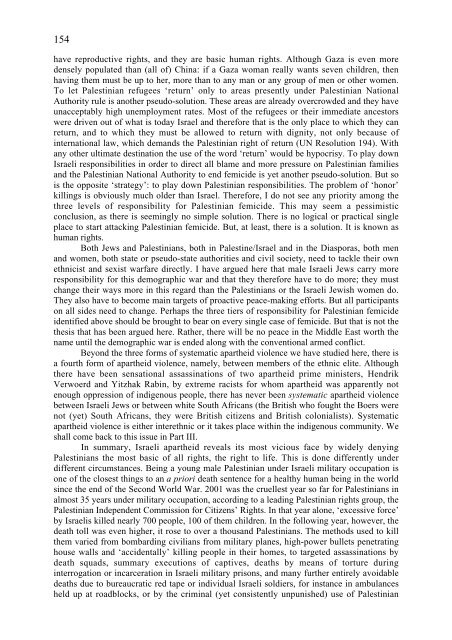Apartheid
Apartheid
Apartheid
You also want an ePaper? Increase the reach of your titles
YUMPU automatically turns print PDFs into web optimized ePapers that Google loves.
154<br />
have reproductive rights, and they are basic human rights. Although Gaza is even more<br />
densely populated than (all of) China: if a Gaza woman really wants seven children, then<br />
having them must be up to her, more than to any man or any group of men or other women.<br />
To let Palestinian refugees ‘return’ only to areas presently under Palestinian National<br />
Authority rule is another pseudo-solution. These areas are already overcrowded and they have<br />
unacceptably high unemployment rates. Most of the refugees or their immediate ancestors<br />
were driven out of what is today Israel and therefore that is the only place to which they can<br />
return, and to which they must be allowed to return with dignity, not only because of<br />
international law, which demands the Palestinian right of return (UN Resolution 194). With<br />
any other ultimate destination the use of the word ‘return’ would be hypocrisy. To play down<br />
Israeli responsibilities in order to direct all blame and more pressure on Palestinian families<br />
and the Palestinian National Authority to end femicide is yet another pseudo-solution. But so<br />
is the opposite ‘strategy’: to play down Palestinian responsibilities. The problem of ‘honor’<br />
killings is obviously much older than Israel. Therefore, I do not see any priority among the<br />
three levels of responsibility for Palestinian femicide. This may seem a pessimistic<br />
conclusion, as there is seemingly no simple solution. There is no logical or practical single<br />
place to start attacking Palestinian femicide. But, at least, there is a solution. It is known as<br />
human rights.<br />
Both Jews and Palestinians, both in Palestine/Israel and in the Diasporas, both men<br />
and women, both state or pseudo-state authorities and civil society, need to tackle their own<br />
ethnicist and sexist warfare directly. I have argued here that male Israeli Jews carry more<br />
responsibility for this demographic war and that they therefore have to do more; they must<br />
change their ways more in this regard than the Palestinians or the Israeli Jewish women do.<br />
They also have to become main targets of proactive peace-making efforts. But all participants<br />
on all sides need to change. Perhaps the three tiers of responsibility for Palestinian femicide<br />
identified above should be brought to bear on every single case of femicide. But that is not the<br />
thesis that has been argued here. Rather, there will be no peace in the Middle East worth the<br />
name until the demographic war is ended along with the conventional armed conflict.<br />
Beyond the three forms of systematic apartheid violence we have studied here, there is<br />
a fourth form of apartheid violence, namely, between members of the ethnic elite. Although<br />
there have been sensational assassinations of two apartheid prime ministers, Hendrik<br />
Verwoerd and Yitzhak Rabin, by extreme racists for whom apartheid was apparently not<br />
enough oppression of indigenous people, there has never been systematic apartheid violence<br />
between Israeli Jews or between white South Africans (the British who fought the Boers were<br />
not (yet) South Africans, they were British citizens and British colonialists). Systematic<br />
apartheid violence is either interethnic or it takes place within the indigenous community. We<br />
shall come back to this issue in Part III.<br />
In summary, Israeli apartheid reveals its most vicious face by widely denying<br />
Palestinians the most basic of all rights, the right to life. This is done differently under<br />
different circumstances. Being a young male Palestinian under Israeli military occupation is<br />
one of the closest things to an a priori death sentence for a healthy human being in the world<br />
since the end of the Second World War. 2001 was the cruellest year so far for Palestinians in<br />
almost 35 years under military occupation, according to a leading Palestinian rights group, the<br />
Palestinian Independent Commission for Citizens’ Rights. In that year alone, ‘excessive force’<br />
by Israelis killed nearly 700 people, 100 of them children. In the following year, however, the<br />
death toll was even higher, it rose to over a thousand Palestinians. The methods used to kill<br />
them varied from bombarding civilians from military planes, high-power bullets penetrating<br />
house walls and ‘accidentally’ killing people in their homes, to targeted assassinations by<br />
death squads, summary executions of captives, deaths by means of torture during<br />
interrogation or incarceration in Israeli military prisons, and many further entirely avoidable<br />
deaths due to bureaucratic red tape or individual Israeli soldiers, for instance in ambulances<br />
held up at roadblocks, or by the criminal (yet consistently unpunished) use of Palestinian

















